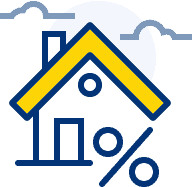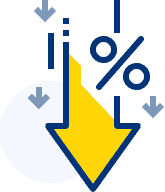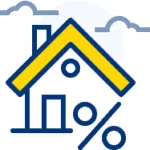Call Live Support


This isn’t necessarily true. Canadian homeowners can unlock their home equity with a second mortgage.
Wondering if you qualify for a second mortgage and how much you could receive? A second mortgage calculator can help you do everything from discovering the cost of the loan to determining your monthly payments.
Understanding the nuances of a second mortgage is crucial, especially for homeowners in Canada. A second mortgage calculator is a handy tool designed to help you unlock the financial potential of your property, enabling you to calculate the loan-to-value (LTV) ratio and the available home equity, and even assess the interest rate and mortgage payments on a second mortgage seamlessly.
A second mortgage is a loan that gives Canadian homeowners access to the equity in their homes. Instead of needing to liquidate the asset, homeowners get the funds they need by “unlocking” the value of their home.
A second mortgage is not merely an additional loan; it represents a strategic financial pathway allowing homeowners to leverage the inherent value embedded within their homes. It’s a sophisticated financial instrument, enabling the conversion of home equity into accessible capital, providing a lifeline for homeowners in need of funds, be it for home improvements, debt consolidation, or other significant expenditures.
This type of loan is sometimes known as a home equity line of credit or HELOC. HELOCs are a little bit different than second mortgages. Both offer access to the equity in your home.
The difference is the type of credit extended by the lender. A second mortgage is like a traditional mortgage or installment loan. You’ll receive the funds in a lump sum, then pay them back over a set period of time.
HELOCs are revolving credit loans. That means they work more like credit cards. You’ll make payments on the outstanding balance, but the funds will be available for you to use again.
Before you get a home equity loan, it helps to understand what equity is and how much you have in your home. So, how do you figure out how much you have?
Equity is the difference between the current market value of your property and any outstanding loans on the property. This includes liens and mortgages.
Suppose your home has a current market value of $1 million. Now imagine you owe about $400,000 on your mortgage. There are no other liens or loans on the property.
Your equity in this property is $600,000. Lenders must factor in the outstanding debt in total loan value. They will go up to 90 percent of the property value.
In this example, your second mortgage could give you up to $500,000 in liquid funds.
If you owned the $1 million property outright, then you may qualify for up to $900,000.
Doing the Math
These calculations can be broken down to show exactly how lenders arrive at them:
Once you know the highest possible total loan amount that can be placed on the property, you can subtract any outstanding loan amounts. This will tell you how much you could get on a second mortgage:
The maximum second mortgage for this property is $500,000. What about the case of the homeowner who already owns the property outright?
The highest loan amount will not change, even if the homeowner has no debt against the property.
A common question from Canadian homeowners is why they should get a second mortgage. As noted, your home is your biggest asset. That means you have funds invested here.
The problem is usually that homeowners can’t access those funds unless they sell the house. With a home equity line, you can get access to those funds. In the example, the homeowner was eligible for half a million dollars.
That’s one of the biggest benefits of a second mortgage. A bank is unlikely to extend a loan that large unless it’s a mortgage. If you still have a mortgage on the property, though, they probably won’t want to give you that much.
Even private lenders may not want to give out a loan that big. The home equity loan is different because it’s secured by the property. The lender feels safer giving out this much loan because they know they can get it back through sale of the house.
That means even Canadian homeowners with bad credit or no income may be eligible. A bad credit second mortgage often has lower rates than other types of loans as well.
There are many reasons Canadian homeowners take out second mortgages. These include:
It’s clear a second mortgage is a flexible tool for Canadian homeowners. Many homeowners only use a portion of the total loan approval. They may use this to fund a renovation or necessary repairs.
Others access their home equity to keep themselves afloat during a tough time. This may be the case for more Canadians in the current environment, as they wait for the job market to rebound.
Debt consolidation with a second mortgage is another popular use. Since the interest rate is usually lower on a second mortgage, it can make payments easier to manage. It can also help Canadian homeowners get rid of bad debts and rebuild their credit.
The loan term may also be longer. That can make the monthly payment more manageable for homeowners.
Call us today to speak to a licenced mortgage broker.
A second mortgage calculator operates by factoring in the current value of your property and any outstanding debts or mortgages against it. It calculates the available equity and assesses the possible second mortgage amount based on a lender’s maximum permissible LTV ratio, allowing you to foresee the estimated monthly payments and interest rates. This intricately designed tool calculates:
1. Home Equity: The difference between the property’s current value and existing mortgages or liens.
2. Loan to Value (LTV) Percentage: It represents the total loans registered against the property in percentage terms, crucial in determining the available loan amount.
3. Interest Rate and Monthly Payments: Based on input values and prevailing market rates, it gives you a glimpse of your potential financial commitment. Understanding and utilizing a second mortgage calculator efficiently can facilitate informed decision-making, aligning your financial strategies seamlessly with your fiscal objectives.
If you’re curious about a second mortgage, then a second mortgage calculator is the best tool available. It can help you look at every aspect of a second mortgage.
The most common use is to calculate the second mortgage value. Most homeowners want to know just how much loan they could get.
Most second mortgage calculators use a simple formula to determine how much loan you could get. This is:
Lenders offer based on what’s known as LTV. “LTV” stands for loan to value, and it’s expressed as a percentage. This is a calculation of the total loans registered on the property.
Consider once again a property valued at $1 million with existing debts totaling $400,000. The current LTV of this property is 40%, as the debts represent 40% of the property’s total value.
Typically, many lenders set their LTV limits to 85% for second mortgages. This means that the combined value of all debts against this property should not exceed $850,000.
With existing debts of $400,000, the homeowner would qualify for a second mortgage amount of up to $450,000. Here’s a breakdown of the calculation:
Existing Debt ($400,000) + Second Mortgage ($450,000) = Total Debt ($850,000)
To find the LTV as a percentage of the property value: (Total Debt / Property Value) * 100 = 85%
This means, that with a second mortgage of $450,000 combined with the existing debt of $400,000, the total debts represent 85% of the property’s value, conforming to the maximum LTV limit set by the lender.
To understand the implications of different LTV limits, let’s look at how varying LTV percentages would affect the qualifying second mortgage amount:
At 80% LTV, a homeowner could potentially obtain a second mortgage of $400,000.
At 70% LTV, the available amount for a second mortgage would be $300,000.
These detailed examples, particularly with an 85% LTV, demonstrate how a second mortgage calculator can offer precise and valuable insights, aiding homeowners in strategically leveraging their property’s value and optimizing their financial planning.
Now that you have gained insights into the operation of a second mortgage calculator in Canada, it is imperative to understand the kind of information you need to input to make the most out of this tool.
Current Market Value of Your Home:
Amount of Outstanding Debt:
Having the right information at your disposal and understanding how to leverage it within the second mortgage calculator can significantly aid in crafting a well-informed and strategically sound financial plan. It enables a more profound and accurate exploration of the financial possibilities and implications of a second mortgage, thereby facilitating smarter and more beneficial financial decisions.
The second mortgage calculator can do more than tell Canadian homeowners how much of a loan they qualify for. You can also use it to get a look at monthly payments, interest rates, and more.
To determine the second mortgage payment, you’ll need to find the interest rate. You’ll also need to know the loan term length.
Second mortgages usually have very short terms. The most common are 3, 6, and 12 months. Other terms are possible, including terms as short as one month.
A second mortgage calculator will use a 12-month term by default. The calculator will also calculate the interest rate for you.
Second mortgage interest rates can be difficult to determine, except for when the mortgage lender tells you what they are. Unless you’ve applied for a loan, then you may not know what interest rate to expect.
That’s because second mortgage interest rates are tied to your loan to value. As a result, you need to know your LTV to determine the interest rate.
Remember, LTV is the total debt against the property. You can calculate it by adding existing debts to the new second mortgage amount. It’s usually expressed as a percentage of the total value of the property.
Once you know LTV, you can calculate second mortgage rates. You’ll want to be sure you use a calculator specific to your province.
That’s because interest rates vary between provinces. A second mortgage calculator for Ontario will use a range of about 6 percent up to almost 14 percent, based on LTV.
How do interest rates vary with LTVs? You can see in this helpful breakdown of ranges:
Sometimes, you want to know the cost of borrowing. In this case, you might want an interest-only second mortgage calculator.
This calculation lets you see the total interest you’ll pay on the mortgage. This can help you weigh the cost of borrowing against other credit products.
To calculate interest only, you’ll need to take the value of the loan and multiply it by the interest rate. That’s the total interest for one year.
Divide this over 12 months to determine the monthly payment for the interest-only second mortgage. Since most loans are on a one-year term, this would be the monthly payment for the entire term of the loan.
Most lenders set interest-only payments for the length of the second mortgage. This means the monthly payment you see is equal to the interest alone.
Interest-only payments can help both lenders and borrowers. By offering interest-only payments, lenders reduce the risk of default. In turn, your monthly payment is much lower and more manageable.
So, how do you pay back the principal? In most cases, the principal is due at the end of the loan term. Depending on the lender, refinancing may be an option.
There is an option to make payments that include both principal and interest. This is much more like a traditional mortgage in that sense. When lenders offer this option, the loan amount will be amortized over 20 or 25 years, just like a traditional mortgage.
It is possible to pre-pay interest. You’ll get less in cash upfront, but you can back the principal faster.
A 2nd mortgage calculator is an incredibly helpful tool for Canadian homeowners who want to see how much of their home’s equity they can unlock. The calculator can help you do everything from estimate payments to discover interest rates.
Are you ready to unlock the equity in your home? Get in touch with a mortgage broker and discover what a second mortgage could do for you.

Low second mortgage interest rates from direct second mortgage lenderes.

Fast second mortgage approval and funding in 48 hours.

Good or bad credit? No problem. All credit history and type accepted.

All income amounts and types accepted for refinancing.

Equity based second mortgage approvals for homeowners.
Getting a second mortgage in Canada is simple and fast. There are no income or credit requirements. Homeowners are approved based on their home equity.

Get your free 2nd mortgage quote with rate and payments.

Confirm property value and existing mortgage details.

Close on your Second Mortgage in just 48 Hours